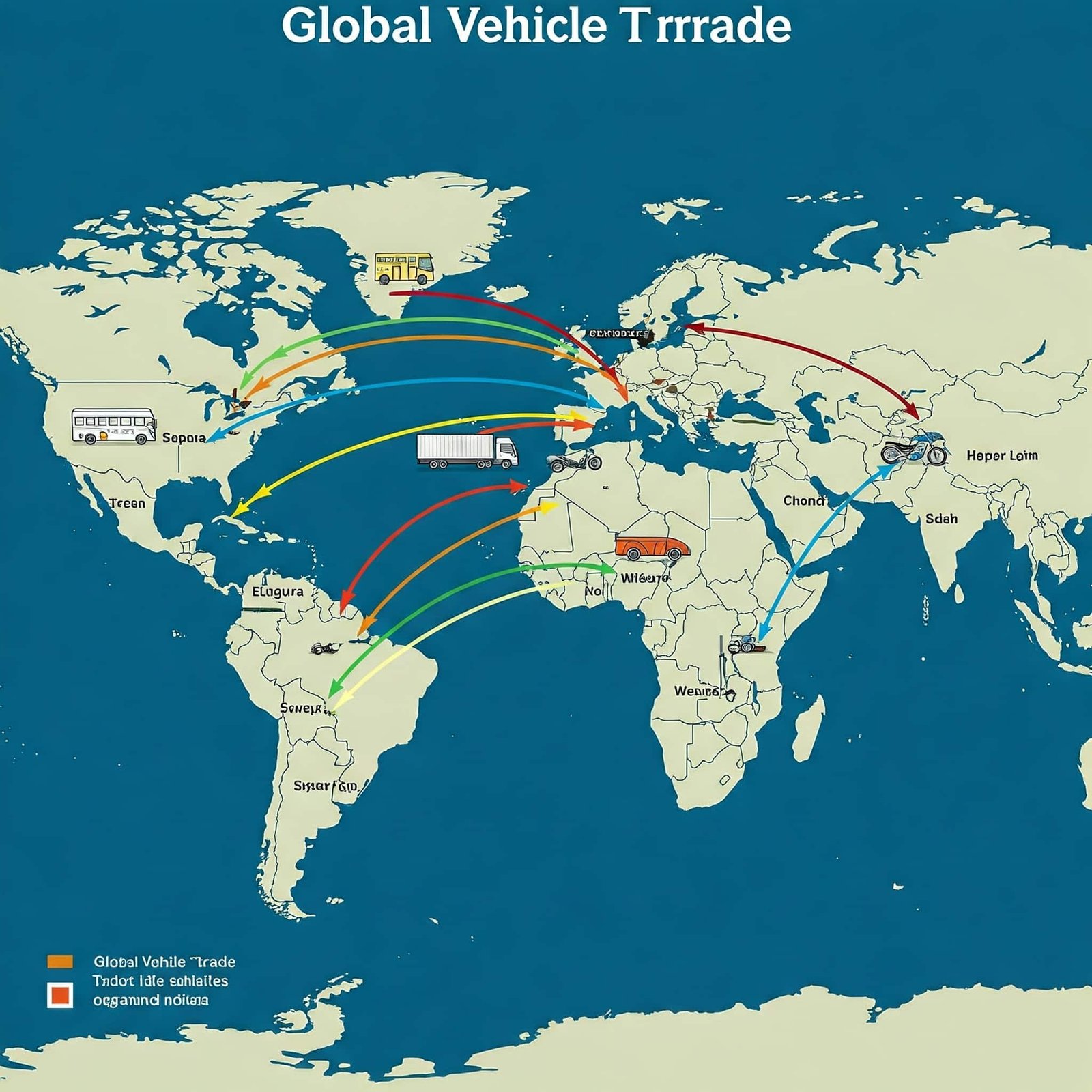Key Statistics at a Glance:
- Worldwide automotive production reached a high of 97.3 million vehicles in 2017 before experiencing a period of decline .
- China has consistently been the top automotive producing country since 2009, with production exceeding 30 million vehicles in 2023 .
- The COVID-19 pandemic in 2020 caused a significant 16% drop in global automotive production, bringing volumes down to levels seen in 2010 .
- Asia has consistently held the largest share of global automotive production, accounting for over half of the total volume in most years .
- Production of electric vehicles (BEVs and PHEVs) saw substantial growth, particularly after 2018, reaching a global share of 8.3% in light vehicle sales in 2021 .
- The United States experienced peak motor vehicle production in 1999 at over 13 million units, but production volumes between 2015 and 2023 ranged from approximately 8.8 million to 12.1 million units .
- Global automotive sales are projected to reach around 89-98 million units in 2025, with production forecasts showing a slight decrease compared to 2024 due to various economic and geopolitical factors .
Introduction: The Global Automotive Production Landscape (2015-2025)
The decade spanning 2015 to 2025 represents a period of significant transformation for the global automotive industry. From steady growth in the early years to unprecedented disruptions and a subsequent recovery, the worldwide automotive production volume has been shaped by a complex interplay of economic forces, technological advancements, and unforeseen global events. Understanding the statistical trends within this timeframe is crucial for journalists, writers, and analysts seeking to grasp the dynamics of this vital sector, which serves as a key indicator of global economic health and technological progress. This comprehensive analysis delves into the annual production volumes, regional shifts, the rise and fall of top producing nations, the major trends that have defined this era, the key drivers behind production, and the significant challenges that have impacted the industry. By examining the statistical data from reputable sources, this report aims to provide a detailed and insightful overview of the global automotive production landscape between 2015 and 2025.
Worldwide Automotive Production Volume: A Detailed Look (2015-2025)
2015: The global automotive industry in 2015 demonstrated a modest upward trajectory. Data from the International Organization of Motor Vehicle Manufacturers (OICA) indicates a total worldwide production volume of 90,780,583 vehicles, encompassing 68,539,516 passenger cars and 22,241,067 commercial vehicles . This figure contrasts with Worldometer’s report of 68,539,516 cars produced, which aligns with OICA’s passenger car production number . It’s important to note that Worldometer’s data focuses specifically on cars, while OICA provides a broader view of total vehicle production. Passenger car demand in 2015 was also reported by ACEA at 72.8 million units, highlighting a slight difference between production and sales figures . Focus2Move reported global light vehicle sales (including cars and light commercial vehicles) reaching 89.7 million units, further emphasizing the distinction between production and sales metrics . Volkswagen’s analysis of the fiscal year 2015 noted 75.6 million new passenger car registrations worldwide, slightly higher than ACEA’s demand figure, suggesting variations in reporting methodologies .
2016: The following year saw continued growth in global automotive production. OICA data reveals a total production of 94,976,569 vehicles in 2016, with 72,105,435 passenger cars and 22,871,134 commercial vehicles manufactured . Worldometer’s count of cars produced in 2016 matches OICA’s figure for passenger cars . ACEA reported global passenger car sales at 77.3 million units, indicating a further increase in demand . MarkLines provided preliminary production volumes for Japanese Original Equipment Manufacturers (OEMs), offering a glimpse into the performance of a significant portion of the global production . This data showed a 3.3% increase in global production volume by these Japanese OEMs, suggesting a broader positive trend in the industry.
2017: Global automotive production reached a peak in 2017, with OICA reporting a total volume of 97,302,534 vehicles. This included 73,456,531 passenger cars and 23,846,003 commercial vehicles . This peak year underscored a period of strong economic activity and consumer demand in many parts of the world. MarkLines continued to track Japanese OEM production, showing a 4.6% increase compared to the previous year . CEOWORLD magazine highlighted that China was the leading passenger car producer in 2017, manufacturing over 24 million units, followed by Japan and Germany, illustrating the geographical concentration of automotive manufacturing .
2018: In 2018, global automotive production experienced a slight downturn, with OICA reporting a total of 95,634,593 vehicles produced. This comprised 70,498,388 passenger cars and 25,136,912 commercial vehicles . The Chicago Fed provided regional production data, indicating varying performance across different parts of the world . Notably, the production in Asia-Oceania declined by about 2%, primarily due to a 4% reduction in China’s output . This marked a shift from the consistent growth observed in previous years. The emerging electric vehicle market continued to gain traction, with global plug-in vehicle deliveries reaching 2.1 million units .
2019: The downward trend in global automotive production continued into 2019. OICA data shows a total production volume of 91,786,861 vehicles, including 67,149,196 passenger cars and 24,637,665 commercial vehicles . This decline of over 5% from the 2018 figure signaled a broader softening in the global automotive market, preceding the major disruptions of 2020. MarkLines reported a 4.0% decrease in production by Japanese OEMs . Road Genius tracked car sales by manufacturer, providing insights into brand-level performance . An OICA press release noted this marked decline and anticipated further challenges in 2020 due to the emerging COVID-19 pandemic .
2020: The year 2020 witnessed an unprecedented crisis for the global automotive industry due to the COVID-19 pandemic. OICA reported a drastic 16% drop in world auto production, with a total of 77,621,582 vehicles manufactured. This included 55,834,456 passenger cars and 21,787,126 commercial vehicles . This volume represented a level equivalent to sales in 2010, effectively wiping out a decade of growth . Europe experienced a significant drop of over 21% in production, while Asia showed more resilience with a decline of only 10%, largely due to China’s quick recovery . IBISWorld data reflected the significant economic impact of this downturn on the global car and automobile manufacturing market .
2021: Following the severe impact of the pandemic, the global automotive industry began a recovery in 2021. OICA data indicates a 3% increase in world motor vehicle production, reaching 80,145,988 units. This comprised 57,054,295 passenger cars and 23,091,693 commercial vehicles . The electric vehicle segment continued its strong growth, with global EV sales more than doubling compared to 2020 . ACEA data provided a regional breakdown of production, showing varying rates of recovery across different continents .
2022: The recovery in global automotive production gained momentum in 2022, with OICA reporting a 6% increase to 85,016,728 vehicles. This included 61,598,650 passenger cars and 23,418,078 commercial vehicles . While this represented a substantial improvement, production volumes were still below the pre-pandemic levels of 2019. ACEA reported a 5.7% increase in global motor vehicle production compared to 2021 . Fastener World highlighted the general growth trend and noted that the Asia-Pacific region remained the largest automobile production region .
2023: By 2023, global automotive production largely returned to pre-pandemic levels. OICA data shows a significant 10% increase, with a total production of 93,546,599 vehicles, including 67,133,570 passenger cars and 26,413,029 commercial vehicles . This strong rebound indicated a recovery in demand and easing of some supply chain constraints. MarkLines reported an 11.1% increase in global production by Toyota, reflecting the overall positive trend . Wards Intelligence focused on global vehicle sales, which also showed a substantial increase, topping 92 million units .
2024: Data and forecasts for 2024 suggest a more stable but still dynamic environment. Wikipedia provides a figure of 95,057,929 for 2024 . ACEA reported global car sales reaching 74.6 million units and car production totaling 75.5 million units . S&P Global Mobility forecasts global light vehicle production to finish at 89.1 million units, a slight decrease compared to 2023 . Automotive World reported a provisional total of 79.22 million light vehicles produced, almost unchanged from 2023 . ABI Research forecasts passenger vehicle sales reaching 94.7 million shipments . These figures indicate a potential plateauing of production after the strong recovery in 2023.
2025: Looking ahead to 2025, forecasts suggest a cautious outlook. S&P Global Mobility projects global light vehicle sales to rise by 1.7% to 89.6 million units, with production levels potentially declining slightly to 88.7 million units due to factors like potential tariffs and economic uncertainties . Just-Auto forecasts the global light vehicle market at 91.6 million units, a 3.4% increase from 2024 . Cox Automotive anticipates US new-vehicle sales reaching 16.3 million units . Dentons predicts global vehicle sales will grow by just 2.7% to 98.7 million units, constrained by economic pressures and potential policy shifts . MarketsandMarkets forecasts global light vehicle sales at 85.1 million units . These various projections highlight a degree of uncertainty in the near-term outlook for the global automotive industry.
Table: Annual Worldwide Automotive Production Volume (2015-2023) (Millions of Units)
| Year | Total Production (OICA) | Passenger Cars (OICA) | Commercial Vehicles (OICA) |
|---|---|---|---|
| 2015 | 90.78 | 68.54 | 22.24 |
| 2016 | 94.98 | 72.11 | 22.87 |
| 2017 | 97.30 | 73.46 | 23.85 |
| 2018 | 95.63 | 70.50 | 25.14 |
| 2019 | 91.79 | 67.15 | 24.64 |
| 2020 | 77.62 | 55.83 | 21.79 |
| 2021 | 80.15 | 57.05 | 23.09 |
| 2022 | 85.02 | 61.60 | 23.42 |
| 2023 | 93.55 | 67.13 | 26.41 |
Regional Production Breakdown: Shifting Gears Across Continents (2015-2025)
The geographical distribution of automotive production has shown distinct patterns and shifts over the 2015-2025 period. Asia has consistently been the dominant region, primarily driven by China’s immense manufacturing capacity . China’s growth as a global manufacturing hub has positioned it as the world’s largest automotive producer since 2009, significantly influencing the overall global production figures . Mature markets like Europe and North America have demonstrated more stability or slower growth compared to Asia. These regions benefit from established automotive industries and strong consumer bases, but their growth has been more moderate in recent years . Emerging markets such as South America and Africa have exhibited more volatility in their production volumes, often influenced by regional economic and political factors . For instance, Brazil showed recovery in some years, while Argentina faced crises that impacted production . Data from ACEA and OICA provide insights into these regional dynamics, highlighting the varying impacts of global events, technological transitions, and economic conditions on automotive manufacturing across different continents .
Top Automotive Producing Nations: A Global Ranking (2015-2025)
The ranking of the top automotive producing nations has seen some notable consistencies and shifts between 2015 and 2025. China has consistently held the top position, with its production volume increasing significantly over the decade, solidifying its status as the world’s leading automotive manufacturer . Other major players that have consistently ranked among the top include the United States, Japan, and Germany . These established automotive powerhouses possess strong industrial infrastructure and have maintained significant production volumes throughout the period. Notably, India has emerged as a significant and growing producer, frequently ranking among the top 5, reflecting its increasing domestic demand and export potential . Countries like South Korea, Mexico, and Thailand have also consistently featured in the top rankings, highlighting their importance in the global automotive supply chain . The shifts in these rankings over the years illustrate the evolving global economic landscape and the changing dynamics of automotive manufacturing across different nations.
Table: Top 5 Automotive Producing Countries (2015-2023) (Millions of Units)
| Year | No 1 (Country) | Production | No 2 (Country) | Production | No 3 (Country) | Production | No 4 (Country) | Production | No 5 (Country) | Production |
|---|---|---|---|---|---|---|---|---|---|---|
| 2015 | China | 24.50 | United States | 12.10 | Japan | 9.28 | Germany | 6.03 | South Korea | 4.56 |
| 2016 | China | 28.12 | United States | 12.20 | Japan | 9.20 | Germany | 6.06 | India | 4.49 |
| 2017 | China | 29.02 | United States | 11.19 | Japan | 9.69 | Germany | 5.65 | India | 4.78 |
| 2018 | China | 27.81 | United States | 11.31 | Japan | 9.73 | Germany | 5.12 | India | 5.17 |
| 2019 | China | 25.72 | United States | 10.88 | Japan | 9.68 | Germany | 4.66 | India | 4.52 |
| 2020 | China | 25.23 | United States | 8.82 | Japan | 8.07 | Germany | 3.74 | South Korea | 3.51 |
| 2021 | China | 26.08 | United States | 9.17 | Japan | 7.85 | Germany | 3.31 | India | 4.40 |
| 2022 | China | 27.02 | United States | 10.06 | Japan | 7.84 | India | 5.46 | South Korea | 3.76 |
| 2023 | China | 30.16 | United States | 10.61 | Japan | 9.00 | India | 5.85 | South Korea | 4.24 |
Trends Shaping the Automotive World: Growth, Drivers, and Disruptions (2015-2025)
Global automotive production between 2015 and 2025 has been characterized by fluctuating growth rates, influenced by a multitude of factors. The period started with moderate growth, reaching a peak in 2017 before experiencing a decline in 2018 and 2019 . The most significant disruption occurred in 2020 with the onset of the COVID-19 pandemic, leading to a sharp contraction in production . The subsequent years saw a gradual recovery, with production nearing pre-pandemic levels by 2023 .
Several key drivers have contributed to these trends. Economic growth and consumer confidence in major markets have historically been strong indicators of automotive demand and production . Technological advancements, particularly the emergence and increasing adoption of electric vehicles, have begun to reshape production strategies and supply chains . Government policies and regulations, such as stricter emission standards and incentives for electric vehicle production and adoption, have also played a crucial role in influencing the types and volumes of vehicles produced .
Significant events have also left an indelible mark on automotive production. Economic downturns in specific regions have dampened consumer spending and production . The rapid advancements in battery technology have accelerated the shift towards electrification . The COVID-19 pandemic stands out as a major disruptor, causing widespread production halts and severe supply chain disruptions . The ensuing semiconductor shortages further compounded these issues, significantly impacting production capacity in the years following the initial pandemic shock .
The 2025 Production Volume: Predictions and Reality
Forecasting the automotive production volume for 2025 involves navigating a landscape of economic uncertainties, evolving consumer preferences, and potential policy shifts. Various organizations have offered their projections, reflecting the complexities of the current environment. S&P Global Mobility anticipates global light vehicle sales reaching 89.6 million units in 2025, with production levels slightly lower at 88.7 million units . This forecast considers factors such as potential tariffs and ongoing challenges in inventory management. Just-Auto offers a more optimistic outlook, predicting the global light vehicle market will reach 91.6 million units . Cox Automotive focuses on the US market, forecasting new-vehicle sales to reach 16.3 million units . Dentons suggests a global vehicle sales figure of 98.7 million units, while MarketsandMarkets projects light vehicle sales at 85.1 million units . These varying forecasts indicate a degree of uncertainty, with the actual production volume in 2025 being contingent on how these influencing factors ultimately unfold. The definitive production figures for 2025 will only become available in 2026, allowing for a comparison between these projections and the realized outcomes.
Key Drivers Influencing Automotive Production (2015-2025)
Economic growth has consistently been a fundamental driver of automotive production. Trends in GDP in major economies directly correlate with consumer demand for vehicles. Strong economic performance typically leads to increased purchasing power and higher demand for automobiles, subsequently boosting production volumes .
Technological advancements within the automotive industry have also played a pivotal role. The increasing focus on electrification is transforming production, with manufacturers investing heavily in developing and producing electric vehicles . While autonomous driving technologies were still in developmental stages during this period, they influenced long-term investment and future production planning . Connectivity features in vehicles have also become a key area of innovation, impacting vehicle design and manufacturing processes .
Government policies and regulations exert significant influence over automotive production. Emission standards, such as the EU’s CO2 reduction targets, have pressured OEMs to accelerate the adoption of zero-emission technologies . Incentives for local manufacturing and for the production or purchase of specific types of vehicles, like electric vehicles, have also shaped production decisions and volumes .
Challenges and Disruptions in the Automotive Supply Chain (2015-2025)
The automotive supply chain faced several significant challenges and disruptions during this decade. Beyond the widely reported semiconductor shortages, the industry experienced issues with the supply of various raw materials, components, and logistical hurdles . The semiconductor shortage, in particular, had a profound impact on production volumes, especially in the years following the COVID-19 pandemic, highlighting the industry’s increasing reliance on the electronics sector . Geopolitical instability, including trade tensions, tariffs, and international conflicts, has also contributed to supply chain disruptions and affected production costs and volumes .
Shifting Consumer Demand and its Impact on Production (2015-2025)
Changes in consumer preferences have significantly influenced the types of vehicles being produced. There has been a notable increase in demand for SUVs and trucks over traditional sedans, prompting manufacturers to adjust their production accordingly . The growing consumer interest in and adoption of electric vehicles has also been a major factor, driving manufacturers to invest in and ramp up the production of EVs . Even features like connectivity and the anticipation of autonomous driving capabilities have played a role in shaping consumer expectations and, consequently, the design and future production plans of vehicles .
Production Volume by Vehicle Type: Passenger Cars vs. Commercial Vehicles (2015-2025)
Analyzing the production volume of passenger cars and commercial vehicles separately provides valuable insights into the dynamics of the global automotive market. Data from OICA indicates that passenger car production generally constitutes a larger share of the total volume compared to commercial vehicles . Fluctuations in commercial vehicle production can often reflect the overall health of the economy, as demand for these vehicles is closely linked to business activity and transportation needs. For instance, the sharp decline in commercial vehicle production in 2020 mirrored the economic downturn caused by the pandemic . The relative proportions of passenger cars and commercial vehicles produced each year offer a nuanced understanding of the factors shaping the automotive industry.
Conclusion: Key Insights and the Road Ahead for Automotive Production
The period between 2015 and 2025 has been a decade of significant shifts and transformations in global automotive production. From a peak in 2017, the industry navigated a period of decline followed by the unprecedented impact of the COVID-19 pandemic. The subsequent recovery has been underway, with production nearing pre-pandemic levels by 2023. Key drivers such as economic growth, technological advancements in electrification, and evolving government regulations have shaped these trends. The industry has also faced substantial challenges, including supply chain disruptions and semiconductor shortages. Shifting consumer demand towards SUVs, trucks, and electric vehicles has further influenced production strategies. While forecasts for 2025 suggest a degree of stabilization, the global automotive landscape remains subject to economic and geopolitical uncertainties. The statistical data from this period provides invaluable insights for journalists and writers covering the automotive sector, highlighting the dynamic nature of this critical industry and its sensitivity to global events and technological progress.







